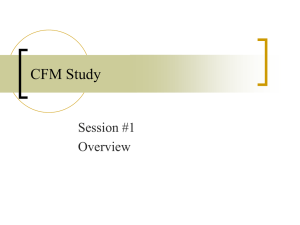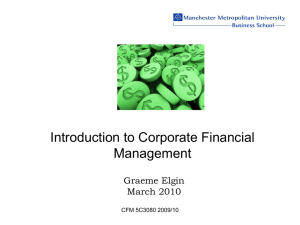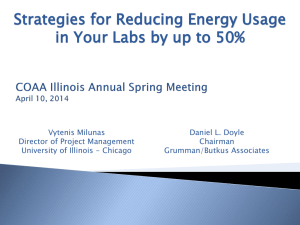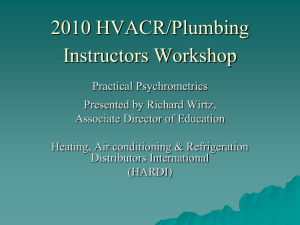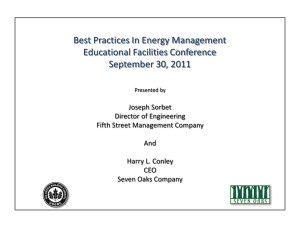California Inter-University Energy & Safety Coalition Webinar
advertisement
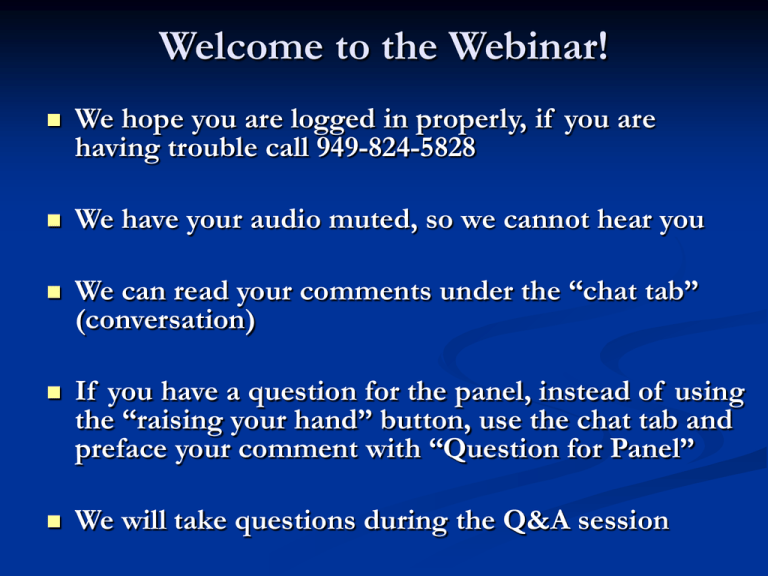
Welcome to the Webinar! We hope you are logged in properly, if you are having trouble call 949-824-5828 We have your audio muted, so we cannot hear you We can read your comments under the “chat tab” (conversation) If you have a question for the panel, instead of using the “raising your hand” button, use the chat tab and preface your comment with “Question for Panel” We will take questions during the Q&A session Inter-University Energy and Safety Coalition Marc Gomez, CIH, CSP, ARM, Interim Assistant Vice Chancellor, Facilities Management / Environmental Health & Safety Lisa Mahar, Senior Manager, Occupational Health and Safety, EH&S Matt Gudorf, LEED-AP, Campus Energy Manager, Facilities Management Meeting Agenda Introductions – Getting to know one another Review of Existing Codes Governing Laboratory Ventilation Challenges to Energy Conservation/Sustainability UCI Low-Flow (High Performance) Fume Hood Permanent Variance Application Overview of Studies and Variance Application Process Next Steps – Variance Hearing, Purchase and Installation Plan, Expansion of Permanent Variance within UCI and other UC Campuses UCOP “Center of Excellence” for Energy Conservation and Sustainability Discussion University of California, Irvine Large research university $16M annual utilities budget Lab buildings consume 2/3 of campus energy Many energy initiatives to reduce carbon footprint Campus Energy $avings Team Synergy Engineers Safety Management Visionary & Supportive Upper Management Supportive Users/ Researchers Patience Facility Managers Balancing Lab Safety & Climate Safety Create lab buildings that out perform ASHRAE 90.1 / CA Title 24 by 50% Combine energy initiatives such as Centralized demand controlled ventilation (CDCV) Low flow (high performance) fume hoods Reduced building exhaust stack airspeeds Energy-efficient lighting Meeting Agenda Introductions – Getting to know one another Review of Existing Codes Governing Laboratory Ventilation Challenges to Energy Conservation/Sustainability UCI Low-Flow (High Performance) Fume Hood Permanent Variance Application Overview of Studies and Variance Application Process Next Steps – Variance Hearing, Purchase and Installation Plan, Expansion of Permanent Variance within UCI and other UC Campuses UCI “Smart Lab” Concept Discussion Meeting Agenda Introductions – Getting to know one another Review of Existing Codes Governing Laboratory Ventilation Challenges to Energy Conservation/Sustainability UCI Low-Flow (High Performance) Fume Hood Permanent Variance Application Overview of Studies and Variance Application Process Next Steps – Variance Hearing, Purchase and Installation Plan, Expansion of Permanent Variance within UCI and other UC Campuses UCI “Smart Lab” Concept Discussion CA Ventilation Code Requirements: Code in Effect California Building Code 2001 Ventilation Requirements B Labs: 6 ACH H-8 Labs: 1 cfm/sf 12 ft ceiling = 5 ACH 10 ft ceiling = 6 ACH 8 ft ceiling = 7.5 ACH California Mechanical B “Research” Labs: Code 2007 0.43cfm/sf 12 ft ceiling = 3.5 ACH 10 ft ceiling = 4.2 ACH 8 ft ceiling = 5.25 ACH B“Science Classroom”/L (H-8): 1 cfm/sf Comments In effect through December, 2007 Existing Construction Effective 1/2008 Refers to ASHRAE 62.1-2004 New Construction No category for university research labs *Need “Alternative Means of Protection” from CA State Fire Marshal for less than minimum required ventilation Meeting Agenda Introductions – Getting to know one another Review of Existing Codes Governing Laboratory Ventilation Challenges to Energy Conservation/Sustainability UCI Low-Flow (High Performance) Fume Hood Permanent Variance Application Overview of Studies and Variance Application Process Next Steps – Variance Hearing, Purchase and Installation Plan, Expansion of Permanent Variance within UCI and other UC Campuses UCI “Smart Lab” Concept Discussion Challenges to Energy Conservation and Sustainability The inability to reduce fume hood face velocity below 100 fpm (Cal-OSHA) CBC/CMC Laboratory Ventilation Requirements ANSI Z9.5 requirement minimum fume hood flow Others? Question: Is Increased ACH Safer? “Specification of Airflow Rates in Laboratories” by Tom Smith, Exposure Control Technologies, Conclusions: ACH as a metric for dilution is “too simplistic”. Must consider other factors that lead to exposure, (i.e. contaminant generation rate, air mixing, etc.) “Increased airflow [may increase] contaminant generation and distribution throughout the space” May lead to “false sense of safety” Answer: Not Necessarily Alternatives to simply increasing ACH: Base air exchange rate on contaminant generation Review lab practices Attain proper air mix ratios Reduce overall ACH to save energy and increase ACH as needed via “smart controls” Meeting Agenda Introductions – Getting to know one another Review of Existing Codes Governing Laboratory Ventilation Challenges to Energy Conservation/Sustainability UCI Low-Flow (High Performance) Fume Hood Permanent Variance Application Overview of Studies and Variance Application Process Next Steps – Variance Hearing, Purchase and Installation Plan, Expansion of Permanent Variance within UCI and other UC Campuses UCI “Smart Lab” Concept Discussion Low Flow (high performance) Fume Hoods Operate safely at lower face velocities (i.e. 70 FPM rather than 100 FPM) Exhaust Plenum Sash Airfoil Work Surface Baffle Increased Hood Depth UCI Low Flow Fume Hood Study 2008 Both traditional and low flow fume hoods were subjected to 168 ASHRAE 110 tests Low flow hoods performed better than standard hoods at 80 & 100 fpm - fully open sash Tracer gas results were well below the 0.1ppm “as used” ASHRAE criteria Low flow hoods save energy, particularly in constant volume systems Low flow hoods may also be a good solution in buildings with limited HVAC capacity Flow & Cost Comparison HVAC System Type and Fume Hood Equipment Flow at 100 fpm nominal face velocity Annual Cost at $5 per CFM Flow at 80 fpm nominal face velocity Annual Cost at $5 per CFM Flow at 70 fpm nominal face velocity Annual Cost at $5 per CFM Constant Air Volume 900 CFM 720 CFM $4500 Institute of Environmental $3600 Variable Air Volume (VAV) Sciences designation: IES-RP-CC-008-84 Good: 682 CFM/$3410 Good: 568 CFM/$2840 Good: 511 CFM/$2555 Poor: 851 CFM/$4255 Poor: 686 CFM/$3430 Poor: 604 CFM/$3020 VAV with ZPS Good: 492 CFM/$2460 Poor: 558 CFM/$2790 630 CFM $3150 Good: 470 CFM/$2350 Good: 462 CFM/$2310 Poor: 539 CFM/$2695 Poor: 530 CFM/$2650 VAV with ASC 361 CFM $1,805 343 CFM $1,715 335 CFM $1,675 VAV with Perfect Sash Management 331 CFM $1,655 325 CFM $1,625 343 CFM $1,715 Flow & Cost Comparison HVAC System Type and Fume Hood Equipment Flow at 100 fpm nominal face velocity Annual Cost at $5 per CFM Flow at 80 fpm nominal face velocity Annual Cost at $5 per CFM Flow at 70 fpm nominal face velocity Annual Cost at $5 per CFM Constant Air Volume 900 CFM $4500 720 CFM $3600 630 CFM $3150 Variable Air Volume (VAV) Good: 682 CFM/$3410 Poor: 851 CFM/$4255 Good: 568 CFM/$2840 Good: 511 CFM/$2555 Poor: 686 CFM/$3430 Poor: 604 CFM/$3020 VAV with ZPS Good: 492 CFM/$2460 Poor: 558 CFM/$2790 Good: 470 CFM/$2350 Good: 462 CFM/$2310 Poor: 539 CFM/$2695 Poor: 530 CFM/$2650 VAV with ASC 361 CFM $1,805 343 CFM $1,715 335 CFM $1,675 VAV with Perfect Sash Management 331 CFM $1,655 325 CFM $1,625 343 CFM $1,715 Study #1 Conclusions Face Velocity & Sash Height All hoods - performed best at 18” sash height All tracer gas results were well under 0.1ppm “as used” ASHRAE criteria At 100, 80, and 60 fpm All low flow hoods performed better than standard hood at 80 & 100 fpm full open sash Study #2 – Exposure Monitoring Low flow fume hoods again passed ASHRAE 110 tests ASHRAE 110 Tests Confirmed Findings from Study #1 All samples were below published Cal-OSHA limits Meeting Agenda Introductions – Getting to know one another Review of Existing Codes Governing Laboratory Ventilation Challenges to Energy Conservation/Sustainability UCI Low-Flow (High Performance) Fume Hood Permanent Variance Application Overview of Studies and Variance Application Process Next Steps – Variance Hearing, Purchase and Installation Plan, Expansion of Permanent Variance within UCI and other UC Campuses UCI “Smart Lab” Concept Discussion Permanent Variance – Next Steps Permanent Variance was requested for 3 UCI research buildings Must make presentation before the Cal-OSHA Standards Board Awaiting hearing date – make take up to 1 year Future plan: Expand permanent variance to cover all of UCI Stretch goal: Extend permanent variance to cover all UC campuses. Meeting Agenda Introductions – Getting to know one another Review of Existing Codes Governing Laboratory Ventilation Challenges to Energy Conservation/Sustainability UCI Low-Flow (High Performance) Fume Hood Permanent Variance Application Overview of Studies and Variance Application Process Next Steps – Variance Hearing, Purchase and Installation Plan, Expansion of Permanent Variance within UCI and other UC Campuses UCI “Smart Lab” Concept Discussion Smart Lab Building Concept Labs w/CDCV real time lab air monitoring 4 ach occupied 2 ach unoccupied Building Exhaust System Energy efficient lighting Labs with low flow fume hoods (as appropriate) Smart Lab Parameters Current Best Practice Air-handler/filtration airspeeds Total system (supply + exhaust) pressure-drop Duct noise attenuators Occupied lab air-changes/hr. (ACH) Night air-change setback (unoccupied) Low-flow/high-performance fume hoods Smart Lab Parameters 400 ft/min. max 350 ft/min. max 6 in. w.g. <5 in. w.g. (incl. dirty filter allow.) Few 6 ACH No setback No None 4 ACH w/contaminant sensing 2 ACH w/occupancy + contaminant sensing + no thermal inputs during setbacks Yes, where hood density warrants Fume hood face-velocities 100 FPM 70 FPM (low-flow hoods) Fume hood face-velocities (unoccupied) 100 FPM 40 FPM (low-flow hoods) Fume hood auto-closers None Where hood density high Exhaust stack discharge velocity ~3,500 FPM Lab illumination power-density 0.9 watt/SF Reduce or eliminate bypass air, wind responsive controls 0 .6 watt/SF w/LED task lighting Fixtures near windows on daylight sensors No Yes Energy Star freezers & refrigerators No Yes 20-25% 50% Out-perform CA Title 24 Bill & Sue Gross Hall A Smart & Sustainable Design Gross Hall Features Centralized Demand Controlled Ventilation - real-time indoor air quality monitoring, varies the ventilation rate Occupancy Based Controls - controls both ventilation system & lighting Natural Ventilation - operable windows linked with mechanical ventilation Smart Lighting Controls - daylighting sensors used with perforated blinds Energy Star Equipment - freezers, refrigerators, ice machines & copiers Air Handling System - larger air handlers accommodate low pressure-drop filtration Building Exhaust - right sized exhaust system eliminates bypass air Exceeding Title 24 Gross Hall Project Exceeded Title 24 By Time Dependant Value As Submitted to Utilities 38% TDV Office Bldg Using Code Chiller 50% TDV 24/7 Using UCI Central Plant with TES 57% TDV 24/7 Estimated annual energy savings: • 890,080 kWh electrical with 193 kW demand reduction • 22,464 therms of natural gas Estimated annual energy cost savings: • $110,980 at $0.105/kWh and $0.78/therm Savings by Design payment of $397,836 Exceeding Title 24 by 50% Bid as a LEED New Construction (NC) Silver Design Build contractor proposed to increase the sustainable features to achieve LEED NC Gold certification Meeting Agenda Introductions – Getting to know one another Review of Existing Codes Governing Laboratory Ventilation Challenges to Energy Conservation/Sustainability UCI Low-Flow (High Performance) Fume Hood Permanent Variance Application Overview of Studies and Variance Application Process Next Steps – Variance Hearing, Purchase and Installation Plan, Expansion of Permanent Variance within UCI and other UC Campuses UCI “Smart Lab” Concept Discussion As A Reminder… We have your audio muted, so we cannot hear you If you have a question for the panel, instead of using the “raising your hand” button, use the chat tab (Conversation) and preface your comment with “Question for Panel” Thank You!
